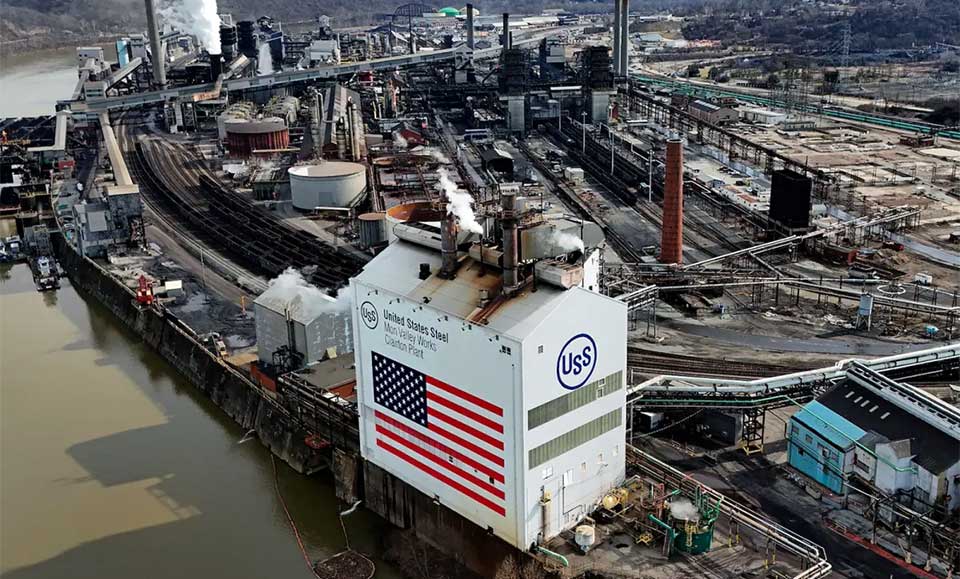
U.S. Steel, once the world’s largest company of any kind, can take substantial credit for the growth of American industrial power in the 20th century. But in recent decades, it’s been shuttering mills and shedding workers. Now, the iconic Pittsburgh-based manufacturer is set to be acquired by a Japanese steelmaker, Nippon Steel — if the federal government allows the deal to proceed.
Earlier this month, reports emerged that the Biden administration is preparing to block the nearly $15 billion merger on the grounds that it presents a threat to America’s national security interests. The United Steelworkers union opposes it, fearing future layoffs and weaker labor protections under new ownership. So do both major candidates for president, who are vying for votes in the Rust Belt. Supporters of the deal, like the Washington Post editorial board and the nonpartisan think tank The Atlantic Council, have cast the politicians’ opposition as election-season pandering and argued that the national security rationale on which Biden may block it is flimsy. But one area, in which the question of whether the merger goes through could be particularly consequential, has gone largely unremarked upon in the conversation: what it means for the climate.
Some environmentalists say the deal could slow the crucial progress that the steel industry must make to decarbonize. Their argument stems from the fact that both U.S. Steel and Nippon Steel have been slow, compared to industry peers, to adopt the most impactful decarbonization technologies, even with federal funding available in the U.S. to do so.
The most common process by which primary steel is produced is massively carbon-intensive. The reasons for this lie in chemistry. Steel is made from iron, but the form in which iron ore occurs in the Earth’s crust is mostly iron oxide (similar to rust). To get usable iron from it, one needs to remove the oxygen. For centuries, iron-makers have accomplished this by using coke, a fuel made from coal, which is heated alongside iron ore in a blast furnace at such high temperatures that the iron melts into a liquid while the oxygen bonds with the carbon in the coke and produces carbon dioxide.
Blast furnaces are responsible for the lion’s share of carbon emissions from steelmaking, and the inextricability of carbon emissions from the ironmaking process is a large part of the reason why, overall, steelmaking is responsible for 7 percent of global carbon emissions, and a quarter of industrial carbon emissions. These percentages will likely grow as other sectors of the economy are decarbonized. In the U.S., steel demand is also expected to grow dramatically over the next decade to provide the raw material of the industrial growth sparked by the Inflation Reduction Act and the planned buildout of clean energy infrastructure and transmission lines. For these reasons, the task of decarbonizing steel is as urgent as it is difficult and expensive.
Fortunately, there is a solution on offer that has recently become viable due to new technological advances — and one that the Biden administration has sought to heavily subsidize: replacing blast furnaces with a process called direct reduction, and using hydrogen as a reducing agent in place of carbon, ultimately discharging water rather than carbon dioxide. “The chemistry is sound, it’s being built, it’s been piloted and demonstrated,” said Yong Kwon, a senior advisor with the Sierra Club’s Industrial Transformation Campaign. “The question is now: Will industries adopt it?”
Eight operating steel mills in the United States make “primary” steel (newly created steel, rather than the generally lower-quality “secondary” steel produced from scrap metal). Three are owned by U.S. Steel. Cleveland-Cliffs, the owner of the other five, has also made an offer to buy U.S. Steel and has been much more proactive in making the shift to greener production. “The Department of Energy has made available a great deal of money to do partnerships with industry to demonstrate the value of decarbonized projects,” said Todd Tucker, director of the industrial policy and trade program at the Roosevelt Institute. Both Cleveland-Cliffs and U.S. Steel have availed themselves of such funding to embark on decarbonization programs. U.S. Steel has partnered with the Department of Energy on carbon capture projects at several of their steel mills, and funded research and development of hydrogen-based ironmaking technology. The company also plans to install a carbon capture program at a blast furnace at its steel mill in Gary, Indiana, which it says will turn up to 50,000 metric tons of carbon dioxide annually into limestone — a tiny fraction of that facility’s overall emissions. But critics note that U.S. Steel has yet to take a step as ambitious as its rival by actually replacing one of its blast furnaces with a direct reduction of iron.
One of the recently announced Cleveland-Cliffs projects will replace a blast furnace at a steel mill in Middletown, Ohio, with a direct reduced iron plant — part of a $575 million award from the Department of Energy. It will not be fossil fuel-free at first. While the company works to secure a reliable source of hydrogen, that plant will initially rely on natural gas to make iron, a process which will still produce carbon emissions, though fewer than the current coal-based process. But in the long term, as low-carbon or carbon-free “green hydrogen” is developed, the new technology presents an opportunity for steel mills to shed their carbon footprint and the Rust Belt to regain lost jobs.
The stakes of the potential U.S. Steel-Nippon Steel merger are perhaps best illustrated in the city of Gary, Indiana, which was built in 1906 by U.S. Steel to house workers at its Gary Works steel mill. That mill is home to the country’s largest and most carbon-emitting blast furnace — and it’s nearing the end of its lifespan. This situation hypothetically presents the furnace’s owner with an ideal opportunity to switch to a cleaner technology, with federal funding on the table to do so. But in August, Nippon Steel announced its prospective plans for Gary Works, which include a $300 million investment in relining the furnace to extend its lifespan for another 20 years. With this announcement, Kwon said, “Not only have they back in Japan not pursued solutions that we feel are responsible; they’ve now explicitly come out and said that they’re not going to pursue the solution that is on the table for reducing the climate change and public health harms that are currently produced by the iron-making process.”










